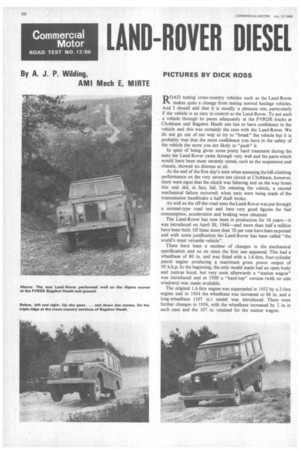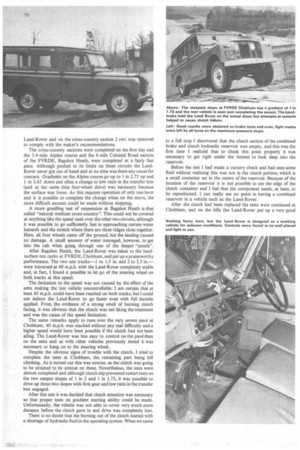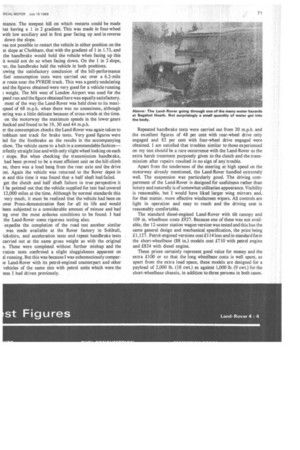LAND-ROVER DIESEL
Page 70

Page 71

Page 72

Page 73

If you've noticed an error in this article please click here to report it so we can fix it.
Commercial Motor
ROAD TEST NO.12/66 By A. J. P. Wilding, PICTURES BY DICK ROSS
AMI Medi E, MIRTE
ROAD testing' cross-country vehicles such as the Land-Rover makes quite a change from testing normal haulage vehicles. And I should add that it is usually a pleasant one, particularly if the vehicle is as easy to control as the Land-Rover. To put such a vehicle through its paces adequately at the FVRDE tracks at Chobham and Bagshot Heath one has to have confidence in the vehicle and this was certainly the case with the Land-Rover. We do not go out of our way to try to "break" the vehicle but it is probably true that the more confidence you have in the safety of the vehicle the more you are likely to "push" it.
In spite of being given some pretty hard treatment during the tests the Land-Rover came through very well and the parts which would have been most severely tested, such as the suspension and chassis, showed no distress at all.
At the end of the first day's tests when assessing the hill-climbing performance on the very severe test circuit at Chobham, however, there were signs that the clutch was faltering and on the way home this unit did, in fact, fail. On retesting the vehicle, a second mechanical failure occurred; when tests were being made of the transmission handbrake a half shaft broke.
As well as the off-the-road tests the Land-Rover was put through a normal-type road test and here very good figures for fuel consumption, acceleration and braking were obtained.
The Land-Rover has now been in production for 18 years—it was introduced on April 30, 1948—and more than half a million have been built. Of these more than 70 per cent have been exported and with some justification the Land-Rover has been called "the world's most versatile vehicle".
There have been a number of changes in the mechanical specification and so on since the first one appeared. This had a wheelbase of 80 in. and was fitted with a 1.6-litre, four-cylinder petrol engine producing a maximum gross power output of 50 b.h.p. In the beginning, the only model made had an open body and canvas hood, but very soon afterwards a "station wagon" was introduced and in 1950 a "hard-top" version (with no side windows) was made available.
The original 1.6-litre engine was superseded in 1952 by a 2-litre engine and in 1954 the wheelbase was increased to 86 in. and a long-wheelbase (107 in.) model was introduced. There were further changes in 1956, with the wheelbase increased by 2 in. in each case and the 107 in. retained for the station wagon. 1958, a Rover 2-litre diesel engine was made available as tal equipment for the first time and early in the same year cries II Land-Rover came into being. This had a slightly ved body styling and the current 2.25-litre petrol engine produces 77 b.h.p. gross at 4,250 r.p.m. and 124 lb. ft. gross at 2,500 r.p.m.
:e in 1958 the 107 in. wheelbase was dropped and from that )nly the 88 in. and 109 in. have been made. In 1961 the al 2-litre diesel was replaced by the 2.25-litre unit as fitted test vehicle, this engine producing 62 b.h.p. at 4,000 r.p.m. 03 lb. ft. at 1,800 r.p.m. All models became the Series IIA same year.
:re have been minor changes to the transmission over the but it has always been basically the same as now with a peed main gearbox (with synchromesh on third and top only) g through a two-speed transfer box which also splits the to the front and rear axles. Four-wheel drive (as well as theel drive only) can be engaged when in high ratio, but the low ratio is engaged four-wheel drive is engaged auto ally to avoid putting too much torque through the rear axle. the main parts of the road test were to be on the fVRDE racks it was decided to carry out the full series of tests, ling normal road running, in this part of Surrey. For most of sts, the vehicle was loaded with 16.5 cwt. of weights to bring ross figure to 2 tons 13 cwt. This was just over 1 cwt. less he maximum rating given to the long-wheelbase diesel-engined
Land-Rover and on the cross-country section 2 cwt. was removed to comply with the maker's recommendations.
The cross-country sections were completed on the first day and the 3.4-mile Alpine course and the 4-mile Colonial Road section of the FVRDE, Bagshot Heath, were completed at a fairly fast pace. Although pushed to its limits on these circuits the Land Rovernever got out of hand and at no time was there any cause for concern. Gradients on the Alpine course go up to I in 2.75 up and in 2.65 down and often a change to low ratio in the transfer box (and at the same time four-wheel drive) was necessary because the surface was loose. As this requires operation of only one lever and it is possible to complete the change when on the move, the more difficult ascents could be made without stopping.
A more gruelling test of suspension at Bagshot Heath is that called "natural medium cross-country". This could not be covered at anything like the speed used over the other two circuits, although it was possible to go sufficiently fast in approaching certain water hazards and the stretch where there are three ridges close together. Here, all four wheels came off the ground, but the landing caused no damage. A small amount of water managed, however, to get into the cab when going through one of the deeper "ponds".
After Bagshot Heath, the Land-Rover was taken to the hardsurface test racks at FVRDE, Chobham, and put up a praiseworthy performance. The two sett tracks—I to 1.5 in. and 2 to 2.5 in.— were traversed at 40 m.p.h. with the Land-Rover completely stable and, in fact, I found it possible to let go of the steering wheel on both tracks at this speed.
The limitation to the speed was not caused by the effect of the setts making the test vehicle uncontrollable. I am certain that at least 45 m.p.h. could have been reached on both tracks, but I could not induce the Land-Rover to go faster even with full throttle applied. From the evidence of a strong smell of burning clutch facing, it was obvious that the clutch was not liking the treatment and was the cause of the speed limitation.
The same remarks apply to runs over the very severe pave at Chobham; 40 m.p.h. was reached without any real difficulty and a higher speed would have been possible if the clutch had not been ailing. The Land-Rover was less easy to control on the pave than on the setts and as with other vehicles previously tested it was necessary to hang on to the steering wheel.
Despite the obvious signs of trouble with the clutch, I tried to complete the tests at Chobham, the remaining part being hill climbing. As it turned out this was unwise, as the clutch was going to be strained to its utmost on these. Nevertheless, the tests were almost completed and although clutch slip prevented restart tests on the two steeper slopes of 1 in 2 and 1 in 1.73, it was possible to drive up these two slopes with first gear and low ratio in the transfer box engaged.
After this test it was decided that clutch attention was necessary so that proper tests on gradient starting ability could be made. Unfortunately, the vehicle was not able to cover very much more distance before the clutch gave in and drive was completely lost.
There is no doubt that the burning out of the clutch started with a shortage of hydraulic fluid in the operating system. When we came to a full stop I discovered that the clutch section of the combined brake and clutch hydraulic reservoir was empty, and this was the first time I realized that to check this point properly it was necessary to get right under the bonnet to look deep into the reservoir.
Before the test I had made a cursory check and had seen some fluid without realizing this was not in the clutch portion, which is a small container set in the centre of the reservoir. Because of the location of the reservoir it is not possible to see the edge of the clutch container and I feel that the component needs, at least, to be repositioned. I can really see no point in having a combined reservoir in a vehicle such as the Land-Rover.
After the clutch had been replaced the tests were continued at Chobham, and on the hills the Land-Rover put up a very good mance. The steepest hill on which restarts could be made iat having a 1 in 2 gradient. This was made in four-wheel with low auxiliary and in first gear facing up and in reverse down the slope.
vas not possible to restart the vehicle in either position on the st slope at Chobharn, that with the gradient of 1 in 1.73, and the handbrake would hold the vehicle when facing up this it would not do so when facing down. On the I in 2 slope, rer, the handbrake held the vehicle in both positions.
lowing the satisfactory conclusion of the hill-performance fuel consumption tests were carried out over a 6.2-mile ar route near the FVRDE track. This was a gently undulating and the figures obtained were very good for a vehicle running ; weight. The M4 west of London Airport was used for the peed run and the figure obtained here was equally satisfactory. most of the way the Land-Rover was held close to its maxispeed of 68 m.p.h. when there was no uneasiness, although :ering was a little delicate because of cross-winds at the time. on the motorway the maximum speeds in the lower gears :heckecl and found to be 19, 30 and 44 m.p.h.
elthe consumption checks the Land-Rover was again taken to hobham test track for brake tests. Very good figures were led for the footbrake as the results in the accompanying show. The vehicle came to a halt in a commendable fashion...rfectly straight line and with only slight wheel locking on each stops. But when checking the transmission handbrake, had been proved to be a most efficient unit on the hill-climb se, there was a loud bang from the rear axle and the drive Dst. Again the vehicle was returned to the Rover depot in in and this time it was found that a half shaft had failed. get the clutch and half shaft failure in true perspective it i be pointed out that the vehicle supplied for test had covered 12,000 miles at the time. Although by normal standards this very much, it must be realized that the vehicle had been on over Press-demonstration fleet for all its life and would been subjected to a considerable amount of misuse and bad ng over the most arduous conditions to be found. I had the Land-Rover some rigorous testing also.
expedite the completion of the road test another similar was made available at the Rover factory in Solihull, ickshire, and acceleration tests and repeat handbrake tests carried out at the same gross weight as with the original e. These were completed without further mishap and the ration tests confirmed a slight sluggishness apparent on al running. But this was because I was subconsciously comparie Land-Rover with its petrol-engined counterpart and other vehicles of the same size with petrol units which were the mes I had driven previously. Repeated handbrake tests were carried out from 20 m.p.h. and the excellent figures of 48 per cent with rear-wheel drive only engaged and 82 per cent with four-wheel drive engaged were obtained. I am satisfied that troubles similar to those experienced on my test should be a rare occurrence with the Land-Rover as the extra harsh treatment purposely given to the clutch and the transmission after repairs resulted in no sign of any trouble.
Apart from the tenderness of the steering at high speed on the motorway already mentioned, the Land-Rover handled extremely well. The suspension was particularly good. The driving compartment of the Land-Rover is designed for usefulness rather than luxury and naturally is of somewhat utilitarian appearance. Visibility is reasonable, but I would have liked larger wing mirrors and, for that matter, more effective windscreen wipers. All controls are light in operation and easy to reach and the driving seat is reasonably comfortable.
The standard diesel-engined Land-Rover with tilt canopy and 109 in. wheelbase costs £927. Because one of these was not available, the 12-seater station wagon version was tested and this has the same general design and mechanical specification, the price being £1,127. Petrol -engined versions cost £114 less and in standard form the short-wheelbase (88 in.) models cost £710 with petrol engine and £824 with diesel engine.
These prices certainly represent good value for money and the extra £100 or so that the long wheelbase costs is well spent, as apart from the extra load space, these models are designed for a payload of 2,000 lb. (18 cwt.) as against 1,000 lb. (9 cwt.) for the short-wheelbase chassis, in addition to three persons in both cases.
























































































































